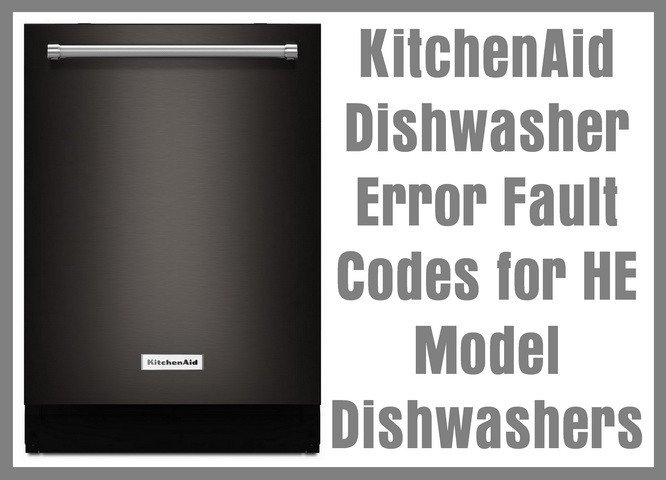
The “HE” error code on a Kitchenaid dishwasher typically indicates a problem with the heating element. This component is crucial because it helps to heat the water, ensuring your dishes come out sparkling clean. When the heating element isn’t performing as it should, your dishwasher sends out an SOS in the form of this error code. While it might seem daunting at first, understanding the common causes can demystify the issue and guide you toward a solution. Let’s delve into the likely culprits behind this error and how you can tackle them.
Understanding the Significance of the Heating Element
Before we jump into the causes, it’s essential to understand what the heating element does in your dishwasher. Think of it like the sun to the earth – it provides the warmth needed for life, or in this case, for cleaning. The heating element is responsible for raising the water temperature, which in turn improves the effectiveness of the dishwasher detergent and ensures that your dishes are sanitized. Without it, your dishwasher is like a cold shower – not very effective.
You might be wondering what happens if the heating element fails. Well, just like trying to wash greasy dishes with cold water, your dishwasher struggles without heat. This can lead to spotting, poor cleaning, and possible health risks from unsanitized dishes – definitely scenarios we want to avoid. Hence, the dishwasher’s alert system brings the “HE” error code to your attention, essentially saying, “Hey, I need some help here!”
Replacing a faulty heating element can sound technical, but it’s not an insurmountable task. Many homeowners tackle this issue themselves with a bit of guidance. However, if you’re uncomfortable with handling electrical components, calling a professional is the safest bet.
Key Causes of Error Code HE
The most straightforward explanation for this error code is a burnt-out heating element, which is akin to a light bulb that has blown. Over time and with regular use, the heating element can wear out or suffer damage, leading it to stop working. You might even notice that your dishwasher no longer heats up as it used to before the error code first appeared.
Another potential cause might be related to the wiring or the connections linked to the heating element. Imagine your heating element as a singer and the wiring as the microphone; if the connection is faulty, the performance suffers. Loose or damaged wires can prevent the electrical current from reaching the heating element, making it inactive. This is often harder to diagnose but critical to the proper functioning of your appliance.
Moreover, it’s worth mentioning that sometimes, the error might be due to a glitch in the control board. Think of this as having your remote control misinterpret a button press. If the control board isn’t sending the right signals due to a software hiccup, your dishwasher might believe something is wrong with the heating element even when it’s perfectly fine.
Steps to Troubleshoot and Resolve the Issue
The first step in troubleshooting involves inspecting the heating element. Start by disconnecting the power – it’s always safety first! Once you’ve safely accessed the dishwasher’s inner workings, check for any visible signs of damage to the heating element, such as cracks or burns. If you spot any of these signs, it’s likely time for a replacement.
If the heating element looks intact, take a closer look at the wiring. Follow the connections and look for any loose ends or frayed wires. Tightening connections or replacing damaged wires might just solve the problem. Don’t forget to check the terminals for oxidation or any sort of buildup, which can interfere with electrical flow.
Should these inspections not resolve the issue, a reset of the control board can sometimes do the trick. Like rebooting a computer to fix glitches, a simple reset might resolve the error code. If you’re not getting anywhere, seeking help from a professional technician who can perform a detailed analysis would be the next smart move.
Prevention Tips to Avoid Future Errors
While no appliance is free from hiccups, a little maintenance can go a long way in preventing future headaches. Regularly running your dishwasher on a high-temperature cycle can help keep the heating element in good condition. It’s akin to taking a car for a spin to keep the engine running smoothly.
Inspecting the internal components periodically is another good practice. This proactive approach is like visiting the doctor for regular check-ups – it helps catch potential issues before they become significant problems. Cleaning the dishwasher’s filters and ensuring no foreign objects are stuck in the components can also contribute to its longevity.
Lastly, consider using quality dishwasher detergents and additives that are compatible with your appliance. Some products are designed to leave fewer residues, which can extend the life of your heating element and other parts. A little care and attention can keep your dishwasher humming along happily for years to come.
With these insights and steps, you’re better equipped to tackle the “HE” error code like a pro. From understanding the role of the heating element to preventive care, you’re now armed with knowledge to handle this common issue. Remember, whether you decide to DIY or call in an expert, it’s all about ensuring your dishwasher continues to make your post-meal cleanup a breeze!